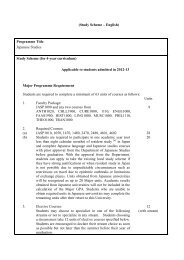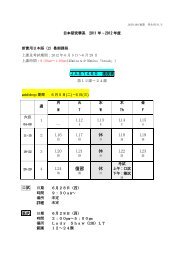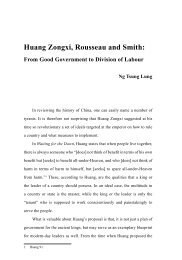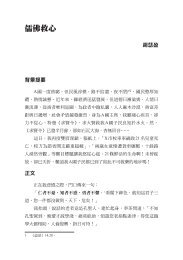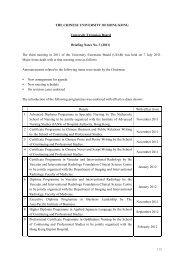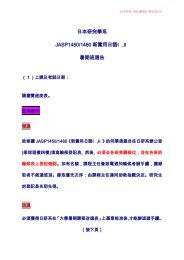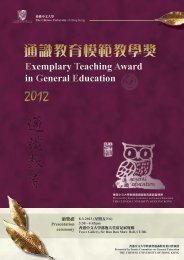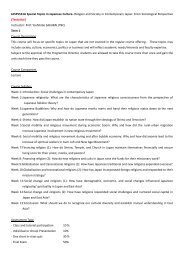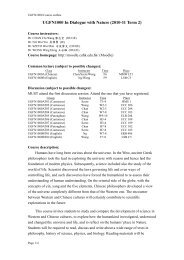ä¸è¼å ¨æ¸ - The Chinese University of Hong Kong
ä¸è¼å ¨æ¸ - The Chinese University of Hong Kong
ä¸è¼å ¨æ¸ - The Chinese University of Hong Kong
You also want an ePaper? Increase the reach of your titles
YUMPU automatically turns print PDFs into web optimized ePapers that Google loves.
Susan Gano-Phillips, Affective Learning in General Education 17<br />
Table 1<br />
Intended Student Learning Outcomes<br />
Written at Each Level <strong>of</strong> the Affective Taxonomy<br />
Receiving:<br />
Responding:<br />
Valuing:<br />
Organization:<br />
Characterized<br />
by a value<br />
(or value set):<br />
Student will be able to listen to different points <strong>of</strong> view<br />
on ethical issues in genetics and biotechnology<br />
Student will be able to assist teammates in solving<br />
problems in genetics and biotechnology<br />
Student will be able to justify a position regarding the<br />
use <strong>of</strong> genetic experimentation from an ethical point <strong>of</strong><br />
view<br />
Student will be able to adhere to ethical standards in<br />
discussing issues in genetics and biotechnology<br />
Student will be able to display commitment to using<br />
ethical standards when solving problems in genetics<br />
and biotechnology<br />
(S. J. Friedman, personal communication, June 6, 2009)<br />
Teaching and Learning Activities (TLAs) to Promote the<br />
Achievement <strong>of</strong> Affective Learning Outcomes<br />
Once affective ILOs have been specified, faculty must turn their<br />
attention to designing TLAs to support students’ achievement <strong>of</strong> those<br />
ILOs. <strong>The</strong>re is growing awareness that traditional pedagogical methods<br />
involving faculty lecturing to large groups <strong>of</strong> students is not always the most<br />
effective strategy for the achievement <strong>of</strong> certain cognitive, and perhaps more<br />
important, affective outcomes (Harward, 2007; Kuh, Kinzie, Schuh, & Whitt,<br />
2005). Instead, pedagogies that allow students to engage more actively in



